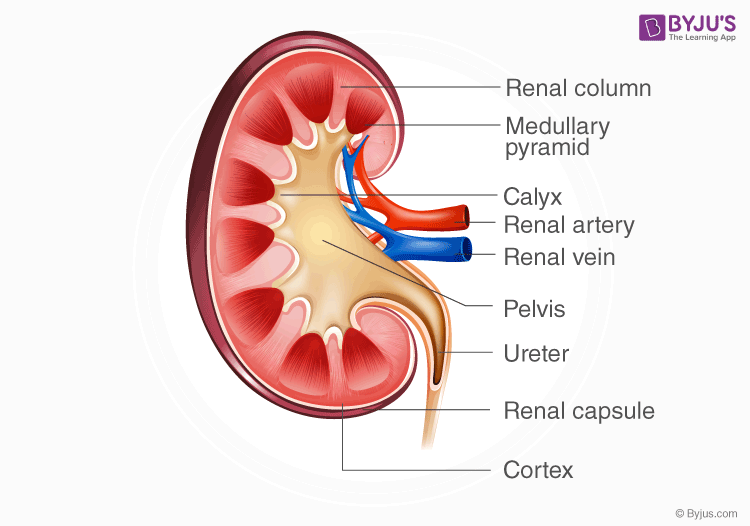The structure of human kidney can be seen as two reddish bean-shaped organs that are located below the rib cage on each side of the spine. They are almost a fistful in size, measuring around 10-12cm. Kidneys are the main organs in the human excretory system, which takes part in the filtration of the blood before the urine is formed. Let us look at the structure of the organ for a better understanding.
External and Internal Features of Kidney
- It has a convex and concave border.
- Towards the inner concave side, a notch called the hilum is present through which the renal artery enters the kidney and the renal vein and ureter leave.
- The outer layer of the kidney is a tough capsule.
- On the inside, the kidney is divided into an outer renal cortex and an inner renal medulla.
- The hilum extends inside the kidney into a funnel-like space called the renal pelvis.
- The renal pelvis has projections called calyces(sing: calyx).
- The medulla is divided into medullary pyramids, which project into the calyces.
- Between the medullary pyramids, the cortex extends as renal columns called Columns of Bertini.
- The kidney is made up of millions of smaller units called nephrons which are also the functional units.
Read: Nephrons
A simple structure of kidney can be understood by the following diagram:

Function
- The most important function of the kidney is to filter the blood for urine formation.
- It excretes metabolic wastes like urea and uric into the urine.
- It secretes a number of hormones and enzymes such as:
- Erythropoietin: It is released in response to hypoxia
- Renin: It controls blood pressure by regulation of angiotensin and aldosterone
- Calcitriol: It helps in the absorption of calcium in the intestines
- It maintains the acid-base balance of the body by reabsorbing bicarbonate from urine and excreting hydrogen ions and acid ions into the urine.
- It also maintains the water and salt levels of the body by working together with the pituitary gland.
Read: Urine Formation
Diseases related to Kidneys
1. Uremia
In uremia, the kidneys are damaged, and there is a buildup of urea and other toxins in the blood, which is fatal and can cause kidney failure. Patients may experience fatigue, itching, muscle twitching, and loss of mental concentration. The urea can be removed by the process of hemodialysis.
2. Renal Calculi
Commonly called kidney stones, these are deposits of salt and minerals in our body. Symptoms include severe abdominal pain and nausea. The stones can be dissolved with medicines, or it passes with urine by improving diet and water intake.
3. Glomerulonephritis
It is the inflammation of the glomerulus. Symptoms include pink urine, oedema or swelling on the face and high blood pressure. It requires medical attention for prevention.
Note: Any person with high blood pressure and diabetes is more prone to kidney related diseases.
Explore BYJU’S Biology to learn more.
Also see:
- Facts about Kidneys
- Regulation Of Kidney Function
- Kidney Function Test
- Kidney Failure Symptoms
- Difference Between Left and Right Kidney
FAQs
What are the first signs of kidney problems?
You can see blood in your urine and it is also foamy. You will have a problem concentrating on things and will face swelling and dryness on your skin.
Can you live without a kidney?
It is not possible to live without a kidney. But since we have two of them, it is possible to survive with one kidney.
What causes kidney problems?
People with diseases like diabetes and high blood pressure have a high chance of developing kidney problems.

Thanking you Team Biju’s for this knowledge free of cost 😊